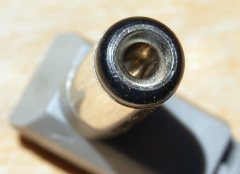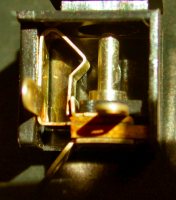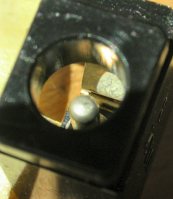
|
Power
Adapters
|
|
|
Power adapters (a.k.a. wall transformers or wall-warts) plug into a wall outlet and supply power to your pedals,
synthesizers, and accessories.
When a wall wart burns out or gets lost you can often
substitute a generic replacement but you have to know
THESE FOUR THINGS:
|
|
1 — The Output Voltage
|
|
Wall adapters transform the house
voltage,
120 V AC, to a lower voltage, usually between 3 V and 18 V.
The adapter's OUTPUT may be either alternating or direct current, AC or DC.
The OUTPUT specs are printed on the adapter. Your replacement adapter
and the original must match as to OUTPUT: AC or DC and
OUTPUT: VOLTAGE.
For example, a pedal that uses a 9V battery
needs an adapter output of 9 V DC since all batteries are DC. If
the output is 9 V AC, it's the wrong adapter.
|


OUTPUT: 15V AC, 320mA
AC has no polarity

OUTPUT: 9V DC, 300mA
POLARITY:
Center positive

OUTPUT: 12V DC, 300mA
POLARITY:
Center negative

|
|
2 —
The DC Polarity
|
|

This photo shows a "coax" plug (short for coaxial).
Coax plugs are commonly used on adapter cables.
They have two metal contacts, a center socket and an outer barrel,
separated by a black insulator.
DC Outputs can have either their positive or their negative terminal connected to the center contact.

This is the symbol for a center-negative connector. A center-positive
connector would have the plus and minus signs reversed.
A backwards polarity can damage your
gear so be sure the polarity pictured on the adapter matches the polarity
pictured on your gear.
If you're comfortable repairing electrical cables, you can reverse the
polarity of a power adapter. With the wall wart
out of the wall, cut the 2-wire coax cord somewhere in the middle.
Then reconnect the wires
in reverse. Use solder and heat shrink tubing if possible.
|
|
3 — The Pin Size
|
|


Like the plugs, coax jacks have 2 metal contacts: a center pin and an outer spring.
The pin of the jack must fit snugly into the center socket of the plug.
Common pin diameters are 2.1 mm and 2.5 mm.
Barrel diameters also vary so, if you can, take your device with you when you shop for an adapter, making sure
its plug fits the device without wobbling.
In some older gear, 1/8" phone plugs and jacks are used instead of co-ax connectors.
|
|
4 — The Current Rating
|
|
Wall adapters can only supply a limited amount of current. The
adapter will overheat and fail if it can't supply all the current your
gear needs to operate. Make sure your replacement adapter can supply
at least as much current as the original adapter.
The current rating is listed on the adapter in amps (A) or milliamps (mA).
Fuzz boxes can draw as little as 10 mA of current while chorus and delay pedals can draw several hundred milliamps.
Portable keyboards and synthesizers can draw as much as 1500 mA (1.5 A)
or more.
Adapters are designed to output their rated current at their rated
voltage. If more current is drawn, the voltage will sag.
If less current is drawn, the voltage will rise. For example, the output
voltage of a 9 V adapter with nothing connected to it could measure
up to 12 V.
The same is true for batteries. An old fuzz box, for example, might
sound better with a carbon-zinc battery installed than with a more
modern, alkaline battery. Alkaline batteries have a higher
current rating and so their voltage might not sag to the preferred level.
|
|
Universal Adapters
|
|
Also available are "universal" wall adapters like those shown below. With them, you can select various
output voltages, either polarity, and a variety of plug types and pin sizes.
|
|

Universal Adapter: 3-12 VDC, 500 mA
|

Universal Adapter: 3-12 VDC, 800 mA
|

|
|

Plugs include coax, 1/8" and 1/16" phone
plugs, and battery snaps
|

Lots of coax sizes and
an 1/8" phone plug
|
|

|
|